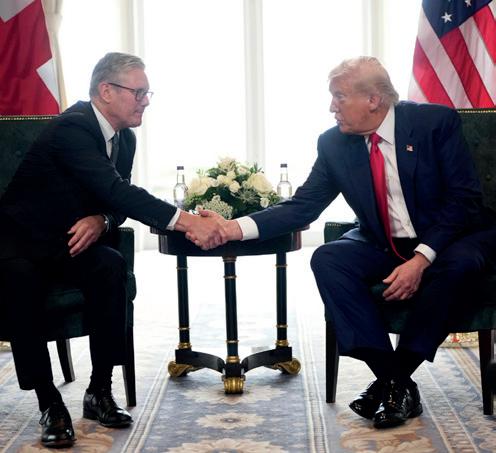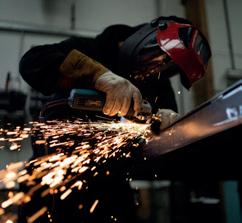
3 minute read
FIRMS ADRIFT IN A SEA OF TARIFFS
British Chambers of Commerce’s Head of Trade Policy, William Bain, takes a look at the latest developments on US tariffs, what they mean for UK businesses and what needs to happen next.
The end of June finally saw some tariff relief for UK companies exporting to the US, as the first elements of the Economic Prosperity Deal (EPD) were implemented.
Automotives
Tariffs on automotive vehicles (cars and light trucks) from the UK were lowered from 27.5 per cent to 10 per cent within an overall quota of 100,000 vehicles per year. This has been split into 25,000 vehicles per quarter with any unused quota being carried over for a maximum of the following two quarters.
For automotive parts, designed for usage with UK manufactured vehicles, the tariffs were also cut to 10 per cent from the end of June. But welcome as this tariff relief is for automotive manufacturers, and their customers in the US, it is still higher than the 2.5 per cent they faced in March.
Aviation
Aviation manufacturers fared better with tariffs on civil aircraft, parts and components reduced to zero from 30 June. This is for all parts included within the terms of the plurilateral World Trade Organisation Agreement on Trade in Civil Aircraft, which both the UK and US have signed. Rules of origin are now intended to be developed to allow for long-term stability.
Steel & Aluminium
That is the extent of the good news for UK firms so far, and attention is now turning to the design and implementation of the steel and aluminium quotas within the EPD. These are meant to reduce to zero the tariffs on UK steel and aluminium, and certain derivative products of both. This is in the context of US steel and aluminium duties for all other countries, apart from the UK, being raised to 50 per cent in mid-June. An initial assessment by the US has not yet yielded any change in the duties on UK steel and aluminium, so they remain at 25 per cent for now, while negotiations continue.
Essential conditions for implementation of US quotas on these products are that UK supply chain policy reflects US national security priorities. The key issue here is the ownership of primary steel and aluminium production assets in the UK (this is largely in connection with Chinese involvement in the Scunthorpe steelworks). Steel production was termed a vital national security issue for the UK in the recent National Security Strategy.
Digital and Technology
UK and US negotiators will also turn their attention to concluding an agreement on technology and digital trade. This has the potential to enhance co-operation on customs facilitations, data, AI and associated technologies. However, the issue of the UK’s digital services tax will likely have to be addressed.
Copper
The EPD contains other commitments of relevance to UK businesses given recent tariff developments in the US. On 9 July, President Trump confirmed that tariffs on imports of copper and derivative products, like conductive wires and cables, will rise to 50 per cent from 1 August.
Although UK exports of these products to the US are relatively small, the EPD contains a commitment to provide the UK with significantly preferential arrangements on the adoption of future tariffs introduced via section 232 investigations, as these are. This is dependent upon the UK ensuring the security of supply chains, and on meeting US concerns raised in those section 232 investigations.
Pharmaceuticals
On pharmaceutical tariffs, the President has proposed raising these massively to 200 per cent. But he has said he will wait a year for further reports before implementing the measure. The UK has secured specific commitments on pharmaceutical tariffs within the EPD, with both sides intending to negotiate significantly preferential outcomes on these for the UK. Hopefully this will mean UK pharmaceutical firms face considerably lower tariffs, but any agreement will again by contingent on meeting supply chain security issues raised by the US.
Reciprocal Tariffs
For other sectors in goods exports, from food and drink, to chemicals, to construction goods, to clothing and textiles, the 10 per cent US reciprocal tariffs have caused significant cost. This has placed pressure on revenues, profits and recruitment for UK businesses over the past three months. There is no commitment to lower these within the


EPD, but it should be used as a platform to address this issue in future negotiations.
Conclusion
The EPD provides reduced tariffs in some sectors and creates some safeguards in others, and it puts the UK, for now, in a more advantageous position than other countries. Steel and aluminium tariffs are half the 50 per cent faced by all other countries exporting these products to the US. The 10 per cent reciprocal tariffs for other UK goods compare favourably against US announcements (unless negotiated outcomes are reached by the end of July) of 50% tariffs on Brazilian goods, 30 per cent on EU and South African goods, 25 per cent on Japan or Malaysian goods, and 24 per cent on South Korean goods from 1 August.



But tariff relief is still needed across more goods sectors in the UK economy with exposure to US export markets. Services trade remains free of tariffs, but if trade in goods declines between the UK and US, services associated with that goods trade cannot be insulated from negative impacts either. UK exporters are resilient and want to see the best trading terms with our key trading zones of the European neighbourhood, the Americas, and Indo-Pacific. Now is the time for trade negotiators across the world to rise to that challenge.











